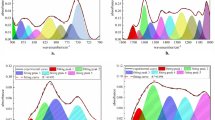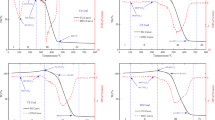Abstract
THE colour of bituminous coal has been variously attributed to large polynuclear condensed aromatics1–3, free radicals4–6, charge-transfer complexes2,7 and free π-electrons8. The chemical-physical causes of colour remain matters of conjecture and will not be treated here; the optical aspects and simulation of colour in coal will be discussed. Thick sections of coal vitrain are black, or opaque in the visible region of the spectrum. For thin sections, however, the transmitted colour progressively changes from brown to red to yellow with decrease in thickness9,10. The yellow colour is characteristic of the thinnest sections that can be successfully made by the normal procedure. The recent success at this laboratory with the grinding of a thin section to form a wedge suggests that, at thicknesses represented by regions near the tip of the wedge, white light is transmitted; that is, the vitrain is clear and colourless11. Similar variations in colour with thickness are observed for carbonaceous derivatives such as some heavy oils, asphalts and pitches from coal and petroleum. This communication presents an explanation for these colour changes, and the production of identical colour-changes with thickness is demonstrated with pure compounds that are lightly coloured or colourless.
This is a preview of subscription content, access via your institution
Access options
Subscribe to this journal
Receive 51 print issues and online access
$199.00 per year
only $3.90 per issue
Buy this article
- Purchase on Springer Link
- Instant access to full article PDF
Prices may be subject to local taxes which are calculated during checkout
Similar content being viewed by others
References
van Krevelen, D. W., Ann. Mines Belg., 53, 750 (1954).
Schuyer, J., Brennstoff.-Chem., 37, 74 (1956).
Akamatu, H., and Magamazu, K., J. Colloid Sci., 2, 593 (1947).
Friedel, R. A., Nature, 179, 1237 (1957).
Friedel, R. A., and Queiser, J. A., Fuel, 38, 369 (1959).
Friedel, R. A., J. Chem. Phys., 31, 280 (1959).
Leicester, J., J. App. Chem. (London), 6, 96 (1956).
van Krevelen, D. W., Coal, 362 (Elsevier Co., Amsterdam, 1961). Kasatochkin, V. I., Dokl. Akad. Nauk S.S.S.R., 86, 759 (1952).
Cannon, C. G., and George, W. H., Proc. Conf. Ultrafine Structure of Coals and Cokes, 290 (British Coal Utilization Research Assoc., London, 1944).
Mackowsky, M. T., Brennstoff.-Chem., 39, S40 (1958).
Taylor, G. H. (personal communication).
Friedel, R. A., Nature, 201, 811 (1964).
Ergun, S., McCartney, J. T., and Walline, R. E., Nature, 191, 1361 (1961); Fuel, 40, 109 (1961).
Brode, W. R., Chemical Spectroscopy, 278 (John Wiley and Sons Inc., New York, 1943).
Judd, D. B., in Analytical Absorption Spectroscopy, edit. by Mellon, M. G. 515 (John Wiley and Sons Inc., New York, 1950).
Author information
Authors and Affiliations
Rights and permissions
About this article
Cite this article
FRIEDEL, R., DURIE, R. & SHEWCHYK, Y. Colour Variations in Bituminous Coal with Thickness of Sections. Nature 210, 939–940 (1966). https://doi.org/10.1038/210939a0
Issue Date:
DOI: https://doi.org/10.1038/210939a0
Comments
By submitting a comment you agree to abide by our Terms and Community Guidelines. If you find something abusive or that does not comply with our terms or guidelines please flag it as inappropriate.



